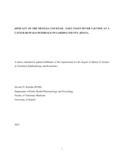Efficacy of the Muguga cocktail east coast fever vaccine at a cattle-buffalo interface in Laikipia county, Kenya

View/
Date
2015Author
Kiraithe, Zaverio N.
Type
ThesisLanguage
enMetadata
Show full item recordAbstract
The study was conducted to assess the efficacy of Muguga Cocktail East Coast Fever (ECF) vaccine at a cattle-buffalo interface in some ranches in Laikipia County.
It is not known with certainty how the current vaccine for cattle against East Coast Fever, that is, Infection and Treatment Method (ITM) using the Muguga Cocktail would perform in areas where buffalos exist with cattle. This is because of the suspicion that buffalo strain of T. parva circulating at the cattle-buffalo interface would lower the efficacy of the ITM with T. parva strains sourced from cattle. The specific objectives of the study were to;
1. Assess the efficacy of ECF vaccine in cattle at a cattle-buffalo interface in Laikipia County.
2 .Determine the viability of the ECF vaccine..
The study was conducted in two ranches which were conveniently selected including Mutara and Ole Naishu with herd sizes of 986 and 2,796 heads of cattle, respectively. A controlled trial was conducted on the two ranches whereby calves were recruited for the study. The calves had no previous history of East Coast Fever (ECF) infection. In both the treatment and control group, a total of 65 immunized and control calves were recruited in each of the ranches. The calves were randomly selected and allocated to immunized and control groups. Calves in the treatment group were injected with Muguga cocktail using a standard protocol developed at the Veterinary Research Institute, Muguga. Prior to the injection of the vaccine, a 30% long acting oxytetracycline was administered at a dose of 30mg per body weight by deep intramuscular injection. Any immunized calf that developed clinical signs of ECF with fever and presence of macroschizonts (7-10 days post immunization) in lymph node smears for at least three days was designated as ―ECF reactor‖. Calves were bled pre-immunization at day 0 and then again 35 days post immunization to determine the antibody response using an Indirect ELISA test, this was to test for the viability of the vaccine. Daily clinical surveillance was kept on all the calves in both the treatment and control groups for twelve months.
The sero-conversion in the vaccinated group was 83% in Ole Naishu and 69% in Mutara. The sero-conversion among the control groups was 3.1% and 6.2% in Ole Naishu and Mutara respectively. xi
The efficacy of the vaccine was established at 97.8% for Ole Naishu, and 78.4% for Mutara. The ECF vaccine (Muguga cocktail) was not as efficacious in Mutara ranch as in Ole Naishu ranch. This may be attributed to sharing of grazing of cattle with buffalos in Mutara which was not the case in Ole Naishu.
Publisher
University of Nairobi
